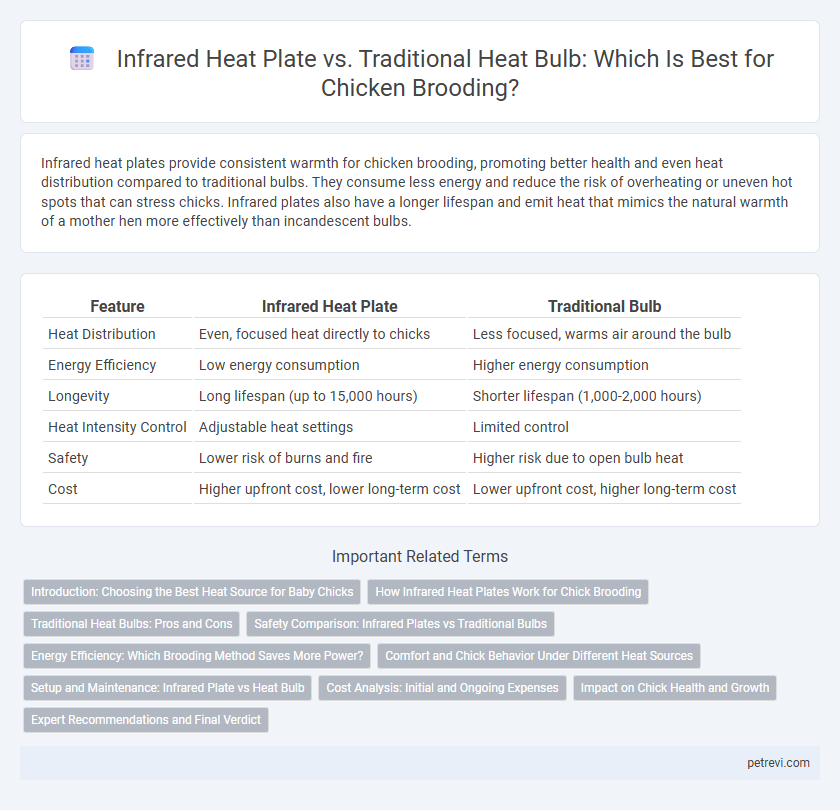Infrared heat plates provide consistent warmth for chicken brooding, promoting better health and even heat distribution compared to traditional bulbs. They consume less energy and reduce the risk of overheating or uneven hot spots that can stress chicks. Infrared plates also have a longer lifespan and emit heat that mimics the natural warmth of a mother hen more effectively than incandescent bulbs.
Table of Comparison
| Feature | Infrared Heat Plate | Traditional Bulb |
|---|---|---|
| Heat Distribution | Even, focused heat directly to chicks | Less focused, warms air around the bulb |
| Energy Efficiency | Low energy consumption | Higher energy consumption |
| Longevity | Long lifespan (up to 15,000 hours) | Shorter lifespan (1,000-2,000 hours) |
| Heat Intensity Control | Adjustable heat settings | Limited control |
| Safety | Lower risk of burns and fire | Higher risk due to open bulb heat |
| Cost | Higher upfront cost, lower long-term cost | Lower upfront cost, higher long-term cost |
Introduction: Choosing the Best Heat Source for Baby Chicks
Infrared heat plates provide consistent, even warmth that closely mimics a mother hen's natural heat, reducing stress and promoting uniform growth in baby chicks. Traditional heat bulbs emit intense, uneven heat that can cause overheating or chilling, posing risks to chick health and development. Selecting infrared heat plates enhances energy efficiency and lowers fire hazards compared to incandescent bulbs, ensuring a safer brooding environment.
How Infrared Heat Plates Work for Chick Brooding
Infrared heat plates emit radiant heat that warms chicks directly without excessively heating the surrounding air, creating a stable and comfortable environment for brooding. Unlike traditional bulbs that rely on convection, infrared plates promote even heat distribution and reduce energy consumption by focusing warmth where chicks gather. This method enhances chick welfare by minimizing drafts and promoting consistent body temperature regulation during critical early growth stages.
Traditional Heat Bulbs: Pros and Cons
Traditional heat bulbs provide consistent, radiant warmth essential for healthy chick development during brooding, promoting steady growth and comfort. However, they consume more energy and generate uneven heat distribution, often creating hot spots that can stress or harm young chicks. Maintenance can be frequent due to bulb fragility and higher heat output, which also increases the risk of fire hazards in brooding environments.
Safety Comparison: Infrared Plates vs Traditional Bulbs
Infrared heat plates provide a safer brooding environment for chickens by emitting consistent, gentle heat and reducing fire hazards compared to traditional bulbs, which are prone to overheating and accidental breakage. Unlike traditional bulbs that can shatter easily, infrared plates are encased in durable materials minimizing risks of injury or burns to chicks. The stable temperature control of infrared heat plates also prevents overheating, enhancing chick welfare and brood mortality reduction relative to traditional heat bulbs.
Energy Efficiency: Which Brooding Method Saves More Power?
Infrared heat plates consume up to 30% less energy compared to traditional incandescent bulbs, making them a more cost-effective choice for chicken brooding. The even heat distribution of infrared plates reduces the need for higher temperatures, further lowering electricity consumption. Traditional bulbs convert more electricity into light rather than heat, resulting in greater energy waste during brooding periods.
Comfort and Chick Behavior Under Different Heat Sources
Infrared heat plates provide a more even and comfortable warmth for chicks, reducing stress and promoting natural behaviors like foraging and exploring compared to traditional heat bulbs that often create hot spots and uneven temperatures. Chicks under infrared plates exhibit less huddling and more active movement, indicating improved comfort and welfare. Traditional bulbs can cause overheating in localized areas, leading to lethargy or avoidance behaviors, while infrared plates ensure consistent heat distribution that supports healthy chick development.
Setup and Maintenance: Infrared Plate vs Heat Bulb
Infrared heat plates offer a streamlined setup with easy mounting options and lower maintenance requirements, as they produce less dust and debris buildup compared to traditional heat bulbs. Traditional bulbs often necessitate frequent replacements and careful positioning to avoid overheating or uneven heat distribution. Infrared plates provide consistent, gentle warmth, reducing the risk of burns, while bulbs require regular monitoring and adjustments to ensure safe and effective brooding conditions.
Cost Analysis: Initial and Ongoing Expenses
Infrared heat plates for chicken brooding typically have a higher upfront cost but offer substantial energy savings compared to traditional heat bulbs, reducing ongoing electricity expenses. Traditional bulbs require frequent replacements due to shorter lifespans, increasing maintenance costs over time, whereas infrared plates often last longer, minimizing replacement frequency. Evaluating total cost of ownership favors infrared heat plates for long-term brooding operations due to efficiency and durability.
Impact on Chick Health and Growth
Infrared heat plates provide consistent, radiant warmth that minimizes stress and promotes even growth in chicks compared to traditional heat bulbs, which often create uneven temperature zones causing chicks to cluster or avoid heat. Infrared plates reduce the risk of dehydration and leg problems by maintaining optimal warmth without excessive light exposure, fostering healthier bone development and higher survival rates. Studies show that chicks brooded under infrared plates exhibit improved weight gain and lower mortality, making them a superior choice for enhancing overall chick health and growth.
Expert Recommendations and Final Verdict
Experts recommend infrared heat plates for chicken brooding due to their energy efficiency, targeted warmth, and reduced risk of burns compared to traditional bulbs. Infrared plates provide consistent heat distribution, promoting healthier chick development and minimizing stress. The final verdict favors infrared heat plates for their longevity, safety, and cost-effectiveness in maintaining optimal brooding temperatures.
Infrared Heat Plate vs Traditional Bulb for Chicken Brooding Infographic

 petrevi.com
petrevi.com